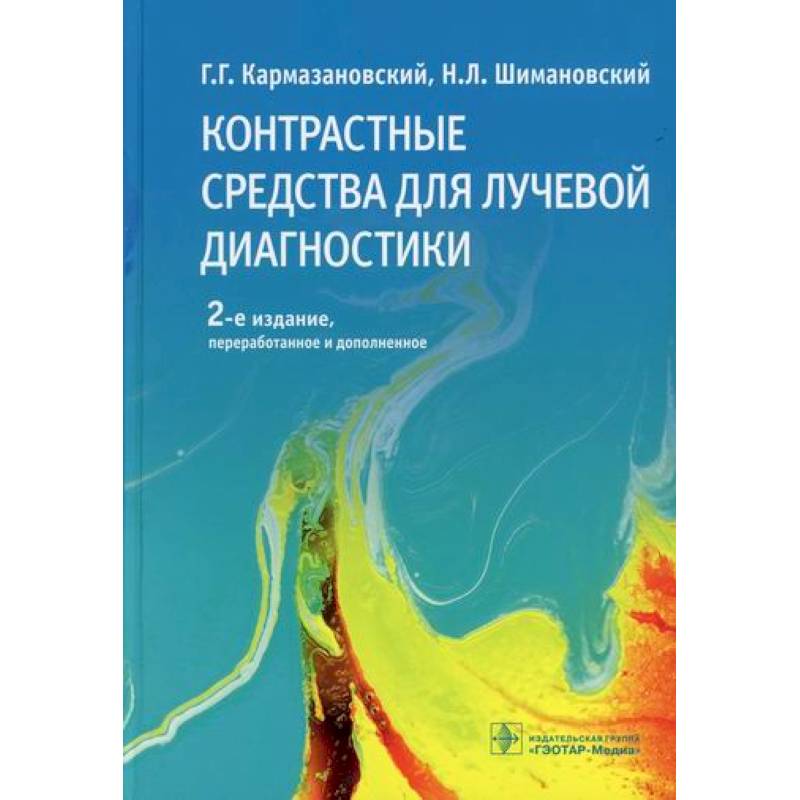Contrasting agents for radiation diagnostics
Please sign in so that we can notify you about a reply
The leadership discusses the methodological features of the use of modern contrast diagnostic agents to increase the efficiency of radiation diagnostics. Their classification based on chemical properties is given.
Modern technologies for using X -ray contrast agents for angiography, endovascular surgery, computed tomography, excretory urography, myelography, lymphography, as well as ways to deliver them to a zone of interest. The physico-chemical properties of iodized radiocontractions are described and their impact on possible adverse reactions. Evidence is given the advantages of monomeric low -swoosmolar drugs compared to dimeric isoosmolar drugs based on experimental and clinical data. Methods of prevention and treatment of undesirable reactions found when using contrast agents are indicated.
The principles of magnetic resonance visualization and the use of magnetic resonance contrasting agents are reflected in the diagnosis of diseases of the central nervous system, including multiple sclerosis, conducting magnetic resonance angiography, to diagnose diseases of the coronary arteries and myocardial ischemia, kidney diseases, joint damage , tumor formations of the mammary gland, uterus, ovaries and hepatobiliary systems. Special attention is paid to the use of gadolinia preparations as X-ray contrast agents, as well as the role of stability of gadolini-containing magnetic resonance contrast agents in the deposit of free gadolinium in oralgnism tissues, including the brain, and in the development of nephrogenic systemic fibrosis as an extreme manifestation of the accumulation of free gadolinium when using unrealizable preparations of the type Gadodiamide or gadoustemide. The advantages of using a single contrasting agent with a double concentration of the gadobutral gadolinium (gadovista) and the hepatospets of the fica agent are described. Information on ultrasound contrast agents and radiopharmaceuticals is presented. Information about the pharmacoeconomics of the use of contrast agents in a modern clinic is given.
The book is intended for radiation diagnosticians, surgeons, oncologists and other specialists who use the technology of radiation research in their work with contrast strengthening, as well as university students studying the topic of “contrasting agents” under pharmacology and radiation diagnostic programs
Modern technologies for using X -ray contrast agents for angiography, endovascular surgery, computed tomography, excretory urography, myelography, lymphography, as well as ways to deliver them to a zone of interest. The physico-chemical properties of iodized radiocontractions are described and their impact on possible adverse reactions. Evidence is given the advantages of monomeric low -swoosmolar drugs compared to dimeric isoosmolar drugs based on experimental and clinical data. Methods of prevention and treatment of undesirable reactions found when using contrast agents are indicated.
The principles of magnetic resonance visualization and the use of magnetic resonance contrasting agents are reflected in the diagnosis of diseases of the central nervous system, including multiple sclerosis, conducting magnetic resonance angiography, to diagnose diseases of the coronary arteries and myocardial ischemia, kidney diseases, joint damage , tumor formations of the mammary gland, uterus, ovaries and hepatobiliary systems. Special attention is paid to the use of gadolinia preparations as X-ray contrast agents, as well as the role of stability of gadolini-containing magnetic resonance contrast agents in the deposit of free gadolinium in oralgnism tissues, including the brain, and in the development of nephrogenic systemic fibrosis as an extreme manifestation of the accumulation of free gadolinium when using unrealizable preparations of the type Gadodiamide or gadoustemide. The advantages of using a single contrasting agent with a double concentration of the gadobutral gadolinium (gadovista) and the hepatospets of the fica agent are described. Information on ultrasound contrast agents and radiopharmaceuticals is presented. Information about the pharmacoeconomics of the use of contrast agents in a modern clinic is given.
The book is intended for radiation diagnosticians, surgeons, oncologists and other specialists who use the technology of radiation research in their work with contrast strengthening, as well as university students studying the topic of “contrasting agents” under pharmacology and radiation diagnostic programs
Author:
Author:Shimanovsky Nikolai Lvovich, Karmazanovsky Grigory Grigoryevich
Cover:
Cover:Hard
Category:
- Category:Medical Books
Publication language:
Publication Language:Russian
ISBN:
ISBN:978-5-9704-6604-9
No reviews found
